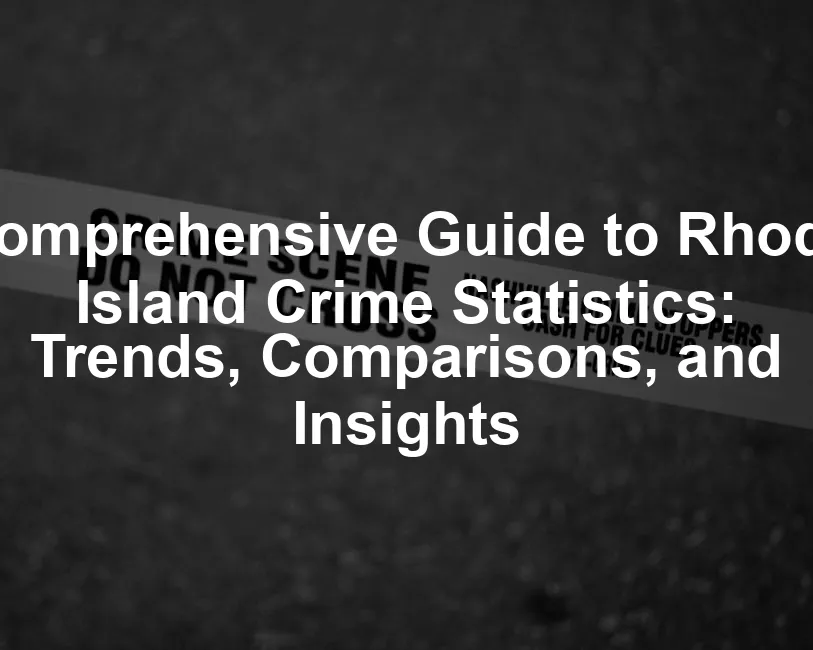Introduction
Understanding crime statistics is crucial for everyone. Residents want safe neighborhoods, while policymakers need data to create effective strategies. Researchers study these statistics to identify trends and inform the public.
Rhode Island, often known for its charming coastal towns and delicious clam chowder, has its own unique crime landscape. While the state is small, its crime rates vary significantly across different regions. Thus, grasping these statistics is essential for community safety and urban planning.
Knowing the crime rates in Rhode Island can help residents feel more secure. Plus, it aids in understanding which areas are relatively safer. For policymakers, this data guides resource allocation and law enforcement strategies. Researchers can analyze the data for patterns and societal impacts.
In this article, you’ll learn about Rhode Island’s crime statistics, including comparisons by city and trends over time. We’ll delve into violent and property crime rates, significant changes, and how they stack up against national averages. By the end, you’ll have a clearer picture of Rhode Island’s crime trends and insights for better decision-making.
If you’re intrigued by crime and its psychological impact, check out The Anatomy of Violence: The Biological Roots of Crime. This book explores the complex interplay between biology and criminal behavior, offering insights that might just change the way you think about crime.

Historical Overview of Crime in Rhode Island
Crime Trends Over the Decades
Rhode Island’s crime history is a tale of peaks and valleys. Since the 1960s, crime rates have experienced fluctuations, often influenced by various societal factors. The 1960s saw a notable rise in both violent and property crime. This trend continued into the 1970s, with crime peaking during the early 1980s.
In 1981, the violent crime rate reached its highest point, with over 400 incidents per 100,000 residents. However, the 1990s brought a change. Crime rates began to decline, leading to a steady decrease into the 2000s. By 2019, the violent crime rate had dropped to about 219 per 100,000 people, a significant improvement compared to previous decades.
Property crimes followed a similar trajectory. In the 1980s, property crime rates soared, with a high of 1,700 incidents per 100,000 people. But by 2019, this figure had fallen to approximately 1,681.3. The reduction reflects improved law enforcement strategies and community engagement efforts.
The peak years of crime highlighted the need for proactive measures. In contrast, the decline indicates effective responses to crime through community programs and law enforcement initiatives. Understanding these historical trends helps residents and policymakers alike to grasp the ongoing evolution of crime in Rhode Island.
Overall, Rhode Island’s crime statistics showcase a significant transformation over the decades. The state’s commitment to safety and community well-being is evident in the declining trends. If you’re interested in the historical context of crime, consider reading The Crime Book: A Chronology of Crime in America. It offers a comprehensive overview of crime trends throughout history.

Comparison with National Averages
When it comes to crime statistics, Rhode Island presents a curious case. Despite being the smallest state in the U.S., its crime rates display interesting trends when compared to national averages. In 2018, Rhode Island’s violent crime rate stood at 219.14 incidents per 100,000 residents. That’s significantly lower than the national rate of 380.56, showcasing that Rhode Island is doing a decent job at keeping violent crime in check.
But wait, there’s more! For property crime, Rhode Island reported a rate of 1,681.3 incidents per 100,000 people. This number, while still substantial, also falls below the national average, which hovers around 2,200. So, kudos to Rhode Island for keeping the property crime rate at bay.
However, not all cities bask in this relative safety. Providence, the state capital, pulls the average up with a staggering violent crime rate of 819 per 100,000 residents. In fact, it’s so high that it sets off alarm bells when you look at the numbers. Comparatively, the national average looks like a relaxing day at the beach.
To illustrate these differences further, let’s break down a few key statistics. The murder rate in Rhode Island sits at around 2.4 per 100,000, while the national average is significantly higher at approximately 5.0. This indicates that while some areas may struggle, the state as a whole is faring better than many others.

Understanding the crime statistics in Providence is essential as it reveals significant challenges compared to the rest of the state. Providence crime statistics
In summary, Rhode Island generally maintains lower crime rates compared to national averages. However, cities like Providence remind us that pockets of higher crime still exist, and vigilance is key for residents and officials alike. To further explore the impact of incarceration on society, check out The New Jim Crow: Mass Incarceration in the Age of Colorblindness.

Breakdown of Crime Statistics by City
Overview of Crime Rates by City
Now, let’s roll up our sleeves and dive into the nitty-gritty of crime statistics by city. Below is a comprehensive table summarizing the crime rates for major cities in Rhode Island, showcasing both violent and property crime rates.
| City | Population | Violent Crime Rate | Property Crime Rate | Murder | Rape | Robbery | Aggravated Assault | Burglary | Larceny-Theft | Motor Vehicle Theft | Arson |
|---|---|---|---|---|---|---|---|---|---|---|---|
| Providence | 180,169 | 819 | 5,679 | 10 | 109 | 248 | 452 | 931 | 4,196 | 552 | 10 |
| Pawtucket | 71,892 | 321 | 1,882 | 0 | 47 | 59 | 215 | 334 | 1,318 | 230 | 9 |
| Warwick | 80,380 | 73 | 1,372 | 1 | 27 | 9 | 36 | 136 | 1,178 | 58 | 8 |
| Cranston | 81,059 | 118 | 1,140 | 0 | 26 | 24 | 68 | 158 | 887 | 95 | 2 |
| Woonsocket | 41,707 | 246 | 898 | 1 | 45 | 43 | 157 | 255 | 572 | 71 | 15 |
| Newport | 24,863 | 85 | 600 | 0 | 22 | 7 | 56 | 79 | 495 | 26 | 4 |
| Central Falls | 19,293 | 83 | 293 | 1 | 12 | 16 | 54 | 47 | 190 | 56 | 4 |
From this table, it’s clear that Providence leads the pack in both violent and property crime rates. With a violent crime rate nearing 819 per 100,000, it’s no wonder residents sometimes feel anxious. Comparatively, Pawtucket shows a violent crime rate of 321, still noteworthy but far less alarming.
On the other hand, cities like Warwick and Cranston exhibit significantly lower crime rates. Warwick’s property crime rate stands at 1,372 incidents per 100,000, while Cranston’s is a bit higher at 1,140. Both cities provide a reassuring environment for families and individuals alike.
It’s also worth noting that Bristol and South Kingstown boast remarkably low crime rates, often cited as some of the safest places in the state. These cities tend to have tight-knit communities and proactive law enforcement, contributing to their safety. If you’re interested in how crime scene investigations work, you might want to check out Crime Scene Investigation: Methods and Procedures. It’s a fascinating read for anyone curious about forensics!

Thus, while Rhode Island has its share of crime challenges, there are many areas where residents can feel secure. Understanding these statistics is crucial for making informed decisions about safety and community engagement.
Case Study: Providence
Providence, as Rhode Island’s capital and largest city, paints an intriguing picture of crime statistics. With a population of around 180,169, it boasts a violent crime rate of 819 incidents per 100,000 residents. Notably, this rate is significantly higher than the national average, which raises eyebrows and concerns alike.
The city is notorious for various violent crimes, including murder, which reported 10 incidents. Other notable figures include 109 rapes, 248 robberies, and 452 aggravated assaults. In terms of property crimes, Providence doesn’t hold back either. It recorded a staggering 5,679 property crimes, with larceny-theft being the most common. The numbers suggest that Providence carries a heavy crime burden, often leading to a sense of unease among its residents.
Trends in Providence show fluctuations, with some years experiencing spikes in violent crime. For instance, the city saw a peak in motor vehicle thefts, causing many to triple-check their parking spots. The implications of these high crime rates in urban settings are multifaceted. They can lead to increased insurance premiums, a reduced quality of life, and even a decline in property values. Thus, understanding these statistics is crucial for residents, city planners, and law enforcement officials aiming for a safer community.

Safe vs. High-Crime Areas
In Rhode Island, crime rates can vary dramatically, much like the weather. Some cities, like Bristol and South Kingstown, report impressively low crime rates. Bristol, for instance, boasts a violent crime rate of just 0.2 incidents per 1,000 residents, making it a sought-after haven for those seeking peace of mind.
Conversely, Providence and Pawtucket showcase high crime rates. Pawtucket, with a violent crime rate of 321 per 100,000, is not far behind Providence in terms of concern. So, what accounts for these discrepancies? Socio-economic factors play a significant role. Areas with lower income levels often struggle with higher crime rates due to reduced resources for education, community programs, and law enforcement presence.
Community programs can serve as a beacon of hope in these high-crime areas. Initiatives that promote youth engagement, job training, and neighborhood watch programs can help mitigate crime. In contrast, cities like Bristol and South Kingstown, with their proactive community engagement and robust law enforcement presence, enjoy the fruits of their labor—low crime rates and a sense of safety.
Ultimately, the stark contrast between safe and high-crime areas in Rhode Island underscores the importance of community involvement and effective law enforcement strategies. Understanding these dynamics empowers residents to advocate for safer neighborhoods and work collectively toward lasting solutions.

Recent Crime Trends and Insights
Changes from 2020 to Present
The COVID-19 pandemic brought unexpected changes to crime trends in Rhode Island. Initially, as lockdowns took effect, many cities reported a surprising dip in crime rates. People stayed home, and property crimes like burglary saw a notable decline. However, as restrictions eased, crime rates didn’t just bounce back—they surged!
Specifically, violent crime rates began to rise alarmingly in 2021. Social unrest and economic hardships contributed significantly to this spike. For instance, Providence saw its violent crime rate jump to approximately 819 per 100,000 residents, a stark contrast to pre-pandemic levels.
Motor vehicle thefts, in particular, became a hot topic. The numbers skyrocketed as people returned to their routines, with a reported increase of over 20% in 2022 alone. This change left many Rhode Islanders feeling uneasy, often investing in additional security measures for their vehicles. If you’re looking to beef up your home security, consider checking out The Complete Guide to Home Security. It’s packed with tips to keep your home safe.
Interestingly, while some crime categories surged, others showed improvement. Burglaries dropped as residents adopted better home security practices. Increased community vigilance played a crucial role in this decline. The numbers suggest that while the pandemic introduced challenges, it also sparked a new wave of community awareness and proactive measures.

The Role of Law Enforcement
Law enforcement agencies in Rhode Island have adapted their strategies in response to these evolving crime trends. Community policing efforts have expanded, focusing on building trust and collaboration with residents. Programs aimed at community engagement have proven effective in addressing concerns and prioritizing resource allocation.
One notable initiative is the “Safe Streets” program launched by the Providence Police Department. This initiative emphasizes transparency and encourages residents to report crimes and suspicious activities. As a result, clearance rates for violent crimes have shown improvement, reflecting the positive impact of these community-oriented strategies.
Furthermore, Rhode Island law enforcement has embraced technology. The use of data analytics to identify crime hotspots allows officers to allocate resources more effectively. This proactive approach enhances public safety and fosters a sense of security among residents.
As the state continues to navigate the complexities of crime post-pandemic, the collaboration between law enforcement and the community remains vital. By working together, they can tackle challenges head-on and strive towards a safer Rhode Island for all. If you’re interested in the psychological aspects of crime, consider Mindhunter: Inside the FBI’s Elite Serial Crime Unit. It delves into the minds of some of the most notorious criminals.

Demographic Breakdown of Crime Rates
Crime rates in Rhode Island often tell a story, but the characters in this tale vary. The statistics reveal significant differences across demographic groups, such as age, ethnicity, and socioeconomic status. For instance, youth crime remains a pressing concern. According to the Rhode Island State Police, individuals aged 18-24 are often involved in a higher percentage of violent crimes, particularly in urban areas. This age group’s impulsive decisions can lead to serious consequences, and community programs targeting this demographic are crucial.
Domestic violence is another area where demographics come into play. Data shows that women, particularly those aged 18-34, are disproportionately affected. In 2018, Rhode Island recorded approximately 4,000 incidents of domestic violence. Understanding these patterns is essential for tailoring interventions and support services.
Socioeconomic status also plays a role. Communities with higher poverty rates tend to experience elevated crime levels. Take Pawtucket, for example, where a significant portion of the population lives below the poverty line. The violent crime rate here is 321 per 100,000, illustrating a connection between socio-economic challenges and crime.

Impact of Community Programs
Community programs have proven to be effective in reducing crime rates across Rhode Island. Initiatives aimed at youth engagement and education have shown promising results. The “Youth in Action” program, for example, focuses on empowering young people through leadership opportunities and community service. This initiative has successfully lowered youth-related crime rates in Providence, demonstrating that proactive engagement can yield positive outcomes.
Moreover, domestic violence prevention programs have made strides in supporting affected individuals. The Rhode Island Coalition Against Domestic Violence provides vital resources and advocacy, leading to increased reporting and support for victims. Statistics show that communities with active support programs report lower incidences of domestic violence.
In areas like Central Falls, community-based policing initiatives have fostered trust between law enforcement and residents. This collaboration has resulted in a significant drop in crime rates, with property crime decreasing by over 20% from 2019 to 2020. These examples highlight the vital role community programs play in shaping safer environments and reducing crime throughout Rhode Island. If you’re looking to improve your personal development, you might enjoy The Subtle Art of Not Giving a F*ck: A Counterintuitive Approach to Living a Good Life. It offers refreshing perspectives on self-improvement.

FAQs
What are the safest cities in Rhode Island?
Cities such as Bristol and South Kingstown consistently rank among the safest in Rhode Island. Bristol has a violent crime rate of just 0.2 incidents per 1,000 residents, while South Kingstown also boasts low property crime rates. These communities benefit from strong local engagement and effective law enforcement.
How do Rhode Island’s crime rates compare to neighboring states?
Rhode Island’s crime rates generally trend lower than those of neighboring Massachusetts and Connecticut. For instance, while Rhode Island’s violent crime rate stands at about 219 per 100,000, Massachusetts hovers around 380. This comparison highlights Rhode Island’s relative safety.
What types of crimes are most prevalent in Rhode Island?
Property crimes, including larceny-theft and burglary, remain the most common in Rhode Island. In 2019, property crimes accounted for over 20,000 incidents statewide. Violent crimes, while less frequent, include assault and domestic violence, which are significant concerns.
How can residents stay safe in higher-crime areas?
Residents can enhance their safety by remaining vigilant, securing their homes, and participating in neighborhood watch programs. Local police departments often offer resources and workshops to educate the community about crime prevention strategies.
What resources are available for crime victims in Rhode Island?
Victims of crime in Rhode Island can access various support services, including the Rhode Island Coalition Against Domestic Violence, which provides shelter and advocacy. Additionally, the state offers hotlines and counseling services to assist those in need.
Please let us know what you think about our content by leaving a comment down below!
Thank you for reading till here 🙂
All images from Pexels




